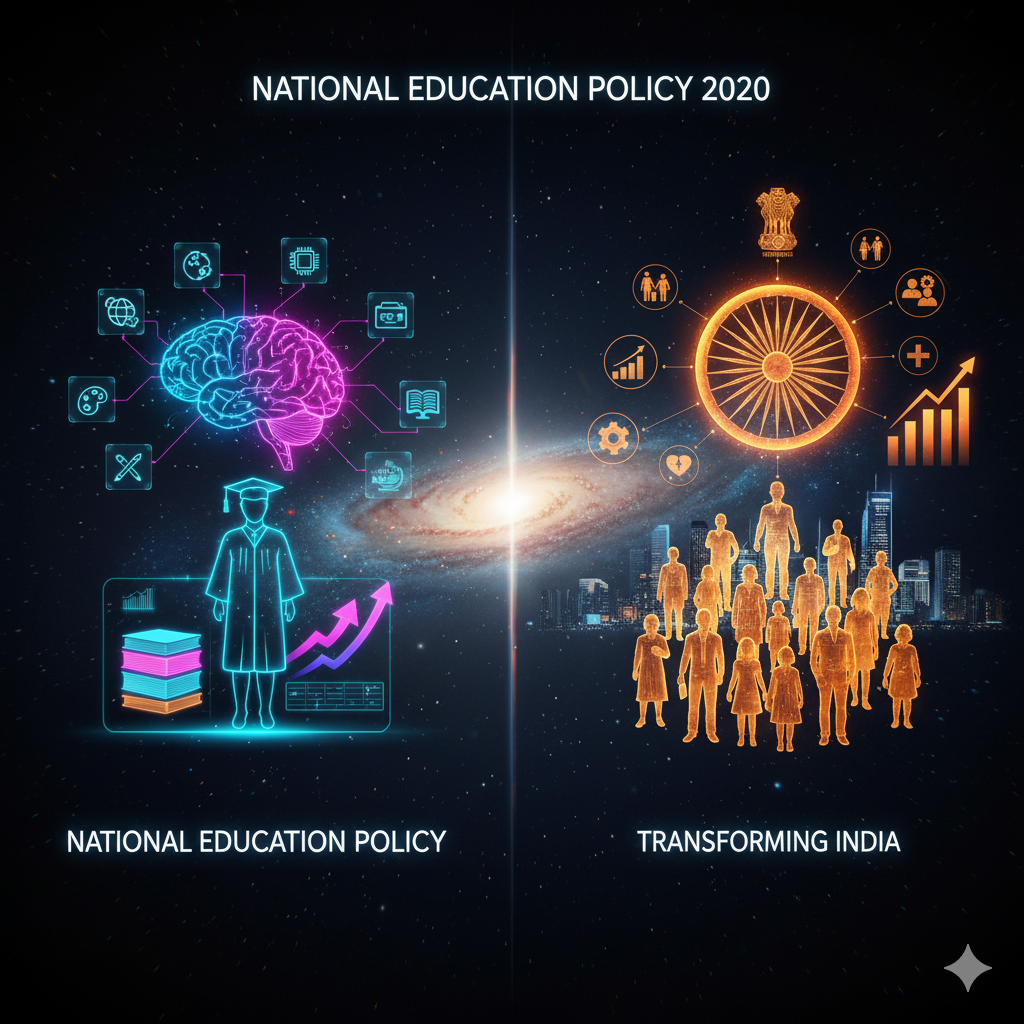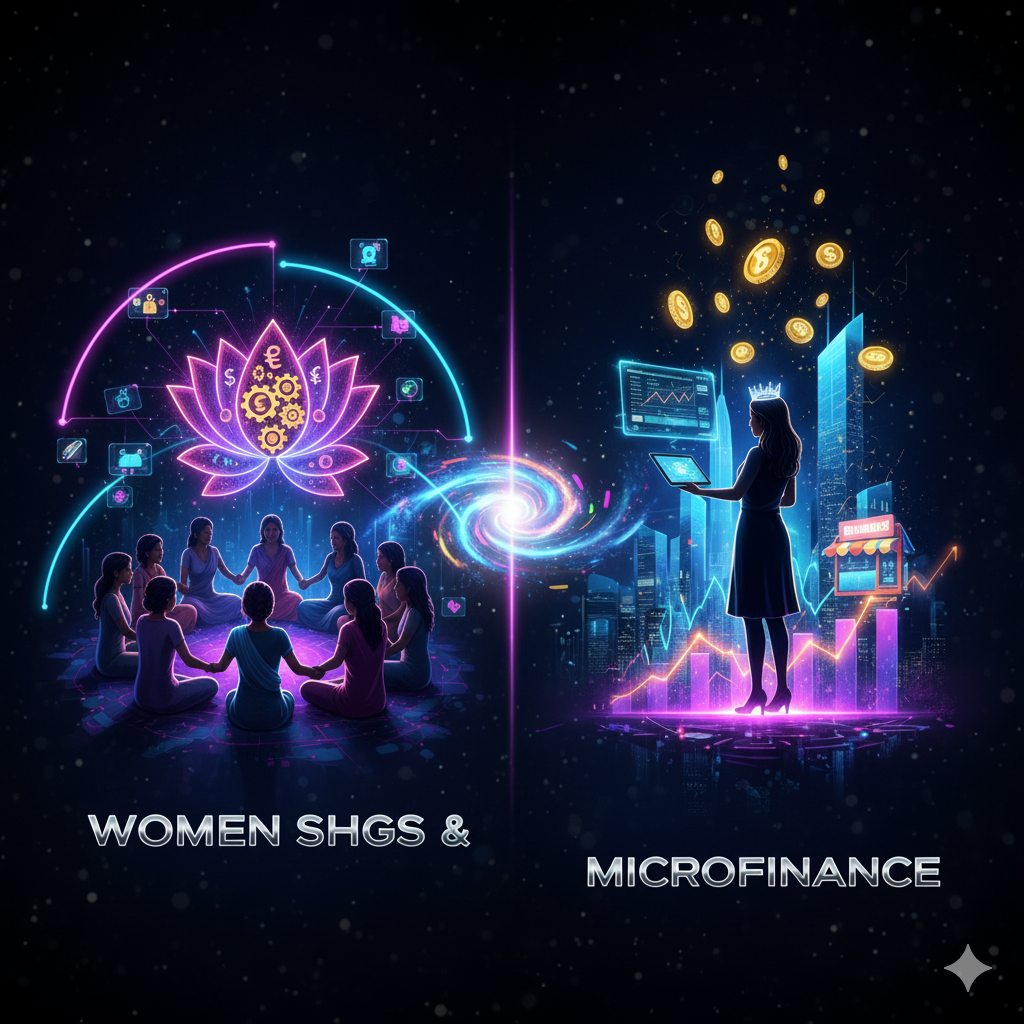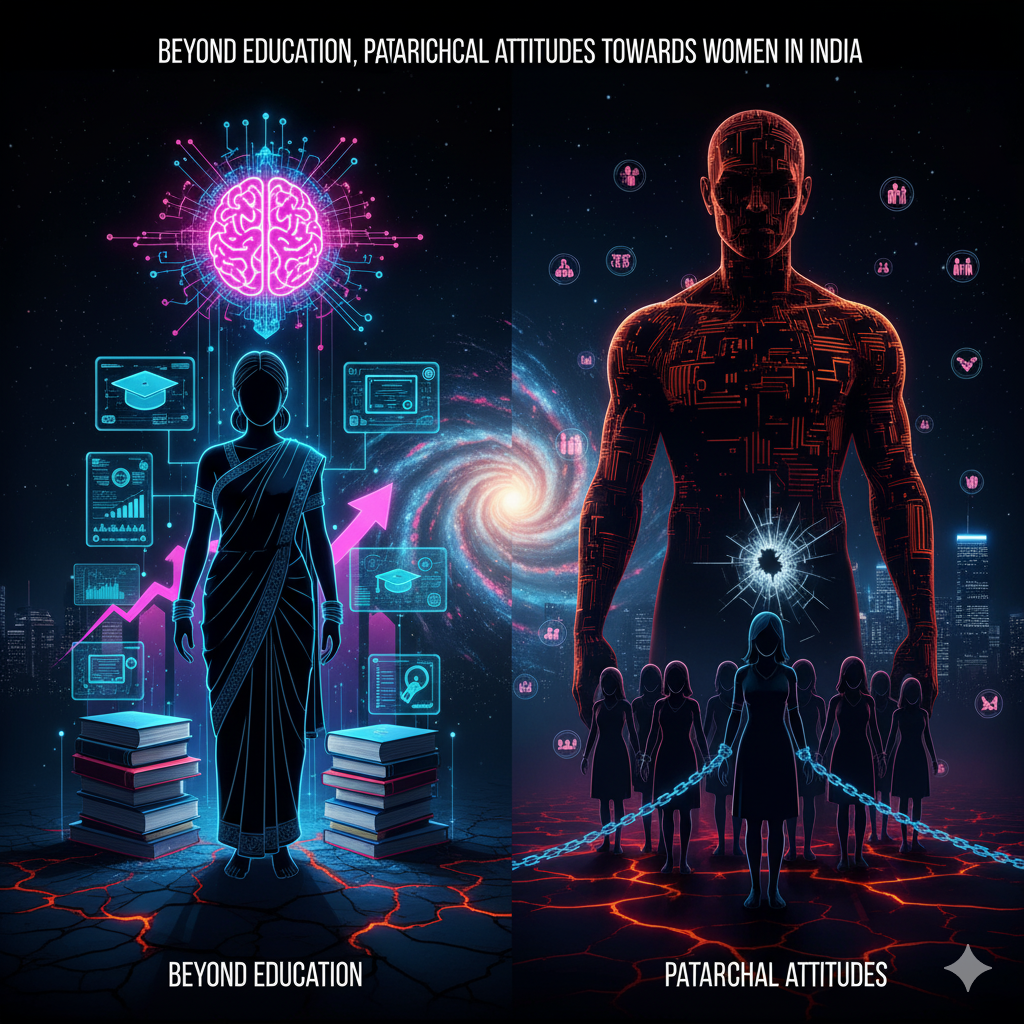Introduction
Education is universally recognized as a cornerstone of sustainable development. It shapes human capital, promotes social cohesion, enhances economic productivity, and equips citizens to tackle the challenges of the 21st century. In 2015, the United Nations adopted the Sustainable Development Goals (SDGs), with SDG-4 emphasizing inclusive, equitable, and quality education for all by 2030. In India, the National Education Policy 2020 (NEP 2020) represents a landmark reform, aimed at overhauling the education system to meet contemporary needs. The policy underscores accessibility, equity, quality, and lifelong learning, resonating with the principles of SDG-4.
The statement that NEP 2020 is in conformity with SDG-4 implies that the policy not only aligns with international educational standards but also addresses India-specific challenges such as regional disparities, gender inequality, skill gaps, and outdated curricula. At the same time, a critical examination requires an assessment of the policy’s strengths, potential gaps, and challenges in translating vision into practice.
Understanding Sustainable Development Goal 4 (SDG-4)
SDG-4 aims to “ensure inclusive and equitable quality education and promote lifelong learning opportunities for all.” Its core objectives include:
- Universal Primary and Secondary Education – ensuring free, equitable, and quality primary and secondary education for all children.
- Early Childhood Development and Pre-primary Education – promoting access to quality early childhood development, care, and pre-primary education.
- Equal Access to Affordable Technical, Vocational, and Higher Education – enhancing skills, employability, and higher education participation.
- Elimination of Gender Disparities – focusing on equality of access and participation across all genders, including marginalized and disadvantaged groups.
- Universal Literacy and Numeracy – ensuring youth and adult literacy and numeracy.
- Safe, Inclusive, and Effective Learning Environments – developing infrastructure, teacher quality, and innovative pedagogical approaches.
- Global Citizenship Education – fostering values, ethics, sustainability awareness, and civic responsibility.
SDG-4 is holistic, encompassing not just access but also quality, equity, relevance, and lifelong learning. NEP 2020, by envisioning a transformation of India’s education system, addresses multiple dimensions of SDG-4.
Overview of National Education Policy 2020 (NEP 2020)
NEP 2020 is the first comprehensive educational reform in India in over three decades. It covers school education, higher education, vocational training, teacher education, and adult education. Key objectives include:
- Universal Access and Inclusion – NEP 2020 envisions 100% enrollment in school and higher education by 2030, focusing on disadvantaged groups.
- Early Childhood Care and Education (ECCE) – introduction of a 5+3+3+4 structure to integrate pre-primary education and foundational learning.
- Curricular and Pedagogical Reforms – competency-based, experiential, and multidisciplinary learning to reduce rote memorization.
- Language Policy – emphasis on mother tongue/local language as the medium of instruction until at least Grade 5, promoting cognitive development and cultural inclusion.
- Vocational and Skill Education – integration of vocational courses from Grade 6 onwards, linking education with employability.
- Higher Education Restructuring – multidisciplinary institutions, flexibility in course selection, credit transfer, and holistic evaluation.
- Equity and Gender Inclusion – special focus on Scheduled Castes, Scheduled Tribes, women, persons with disabilities, and socio-economically disadvantaged groups.
- Teacher Education and Professional Development – rigorous teacher training, professional standards, and continuous development.
- Technology Integration – use of digital tools, e-learning platforms, and AI-enabled education to improve access and quality.
- Regulatory and Governance Reforms – simplification of higher education governance, single regulatory body, and emphasis on autonomy.
The overarching aim is to create a learner-centric, inclusive, flexible, and outcome-oriented education system that prepares students for the modern knowledge economy while retaining India’s cultural heritage.
Areas of Conformity with SDG-4
1. Universal Access and Equity
SDG-4 emphasizes eliminating barriers to education, including financial, social, and geographic. NEP 2020 directly addresses these challenges:
- Introduction of free and compulsory education for children aged 3–18 years, aligning with universal primary and secondary education goals.
- Focused initiatives for marginalized groups, including scholarships, special infrastructure, and gender-sensitive measures.
- Promotion of inclusive classrooms for children with disabilities and learning difficulties.
By targeting the most disadvantaged groups, NEP 2020 seeks to reduce the inequality gap in access to quality education, fulfilling SDG-4’s equity mandate.
2. Early Childhood Care and Education (ECCE)
SDG-4 advocates quality pre-primary education as critical for lifelong learning outcomes. NEP 2020 integrates ECCE into the formal schooling system, emphasizing holistic development, foundational literacy, numeracy, and socio-emotional learning.
- Curriculum redesign ensures play-based, inquiry-driven learning.
- Universal access to Anganwadis and pre-school programs is prioritized to enhance readiness for primary education.
This alignment with SDG-4 ensures that children develop cognitive, social, and emotional skills early, improving retention, learning outcomes, and future employability.
3. Quality Education
SDG-4 is not limited to access; it emphasizes quality learning outcomes. NEP 2020 proposes:
- Competency-based and experiential learning rather than rote memorization.
- Multilingual and interdisciplinary approaches, fostering critical thinking and creativity.
- Periodic assessments replacing high-stakes examinations to measure actual learning.
- Teacher development programs to enhance pedagogical quality.
These reforms aim to improve learning outcomes, ensuring that education equips students with skills relevant to the 21st-century economy, fulfilling SDG-4’s quality objectives.
4. Equity, Gender, and Social Inclusion
NEP 2020 emphasizes equitable access for women, disadvantaged communities, and differently-abled students:
- Gender-sensitive policies encourage equal enrollment and retention of girls, including separate sanitation facilities and safety measures.
- Scholarships, fee waivers, and financial support for marginalized students enhance equity in higher education.
- Focus on regional languages and cultural context reduces socio-cultural barriers.
This focus directly contributes to SDG-4’s mandate of eliminating disparities in education access.
5. Lifelong Learning Opportunities
SDG-4 emphasizes lifelong learning through adult literacy, vocational training, and continuing education. NEP 2020 proposes:
- Skill development and vocational education from Grade 6 onwards.
- Integration of adult education programs and lifelong learning frameworks for youth and adults.
- Digital learning platforms enabling flexible, remote, and inclusive education.
By promoting lifelong learning, NEP 2020 ensures that citizens continually acquire knowledge and skills, aligning with SDG-4 targets for youth and adult literacy.
6. Global Citizenship and Ethical Education
NEP 2020 encourages value-based education, civic responsibility, environmental consciousness, and human rights awareness. These initiatives resonate with SDG-4.7, which calls for education to foster sustainable development, global citizenship, and cultural understanding.
Critical Examination of NEP 2020 in Relation to SDG-4
While NEP 2020 aligns with SDG-4 in principle, a critical analysis reveals both strengths and challenges in practical implementation:
Strengths
- Holistic and Multilevel Reform: NEP 2020 addresses school education, higher education, vocational training, and adult learning, covering the full spectrum of SDG-4.
- Focus on Equity and Inclusion: Special measures for marginalized communities, girls, and differently-abled students promote social justice and equality.
- Integration of Technology: Emphasis on digital infrastructure, online learning platforms, and AI-based teaching enhances accessibility and quality.
- Curricular Modernization: Shift to competency-based learning, critical thinking, and interdisciplinary education equips learners with employable skills.
- Teacher Empowerment: Professional development programs enhance the quality of pedagogy, a key factor in achieving learning outcomes.
Challenges and Gaps
- Implementation Hurdles: NEP 2020 is ambitious, and operationalizing reforms across over 1.5 million schools and hundreds of higher education institutions presents a huge challenge.
- Infrastructure Limitations: Many rural schools lack basic facilities such as classrooms, electricity, toilets, and digital access, limiting the practical impact of policy reforms.
- Teacher Shortages and Training Gaps: Effective pedagogy depends on well-trained teachers. In many regions, teacher shortages and inadequate training may hinder the quality of implementation.
- Socio-Cultural Barriers: Despite policy provisions, entrenched social norms, gender bias, and caste discrimination may continue to restrict access for marginalized groups.
- Funding Constraints: The policy requires substantial investment in infrastructure, teacher training, digital learning, and scholarships. Budgetary constraints may slow down progress.
- Monitoring and Evaluation: Ensuring accountability, measuring learning outcomes, and tracking progress across diverse regions is complex. Robust evaluation mechanisms are essential to realize SDG-4 objectives.
- Digital Divide: While technology is promoted, disparities in internet access and digital literacy may exacerbate existing inequalities, particularly in remote and tribal areas.
Comparative Perspective: NEP 2020 and Global SDG-4 Initiatives
NEP 2020 aligns with international best practices in education:
- Finland emphasizes holistic, learner-centered pedagogy similar to NEP’s competency-based approach.
- UNESCO’s Education for Sustainable Development framework is reflected in NEP’s emphasis on environmental education, ethics, and global citizenship.
- Vocational integration in Germany and Singapore parallels NEP’s focus on early skill development and employability.
However, India faces unique challenges of scale, diversity, and resource constraints. Unlike smaller nations, implementing SDG-4 compliant policies across a population of over 1.4 billion requires decentralized planning, robust monitoring, and adaptive strategies.
Way Forward: Strengthening NEP 2020 for SDG-4
To fully realize NEP 2020’s alignment with SDG-4, the following measures are crucial:
- Enhanced Funding and Resource Allocation: Increased budgetary allocation for infrastructure, teacher training, digital access, and scholarships.
- Teacher Capacity Building: Continuous professional development, teacher incentives, and regional training centers.
- Technology Inclusion: Expanding internet connectivity, providing digital devices, and promoting e-learning in rural and remote areas.
- Monitoring and Evaluation Framework: Establishing robust data collection systems to track enrollment, retention, learning outcomes, and equity indicators.
- Community Participation: Engaging parents, local governance bodies, and NGOs to ensure social acceptance and oversight of reforms.
- Focus on Marginalized Groups: Targeted interventions for girls, SC/ST communities, minorities, and differently-abled students to ensure no one is left behind.
- Integration of Vocational Skills: Strengthening partnerships with industry to ensure skill programs lead to employment opportunities.
By addressing these areas, NEP 2020 can effectively contribute to achieving SDG-4 by 2030.
Conclusion
The National Education Policy 2020 represents a visionary blueprint for transforming India’s education system and aligns substantially with the Sustainable Development Goal 4 (SDG-4). Its emphasis on access, equity, quality, vocational skills, technology integration, and lifelong learning resonates with the international agenda for inclusive and sustainable education.
However, the policy’s success depends on effective implementation, adequate funding, teacher capacity building, technology deployment, and addressing socio-cultural barriers. While NEP 2020 has the potential to create a world-class education system in India, challenges of scale, diversity, and resource limitations must be managed strategically.
In essence, NEP 2020 offers India an opportunity to not only achieve SDG-4 but also redefine education as a driver of social transformation, economic growth, and global competitiveness. A sustained, multi-stakeholder approach that combines policy vision with grassroots execution is essential for realizing the twin objectives of equitable access and quality education for all by 2030.
References (Indicative for Educational Use)
World Bank. (2021). India Education Sector Review. Washington DC: World Bank.
Ministry of Education, Government of India. (2020). National Education Policy 2020. New Delhi: Government of India.
United Nations. (2015). Sustainable Development Goals: Goal 4 – Quality Education. New York: UN.
Tilak, J. B. G. (2021). Education and SDGs in India: Challenges and Policy Reforms. Economic and Political Weekly, 56(17), 35–44.
UNESCO. (2020). Global Education Monitoring Report 2020: Inclusion and Education. Paris: UNESCO.
Rao, V. & Sharma, P. (2021). Implementation Challenges of NEP 2020 in Rural India. Journal of Education Policy, 36(3), 295–312.




